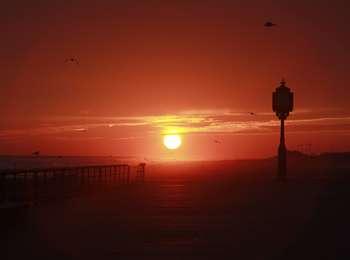Last updated: November 7, 2021
Place
Jacob Riis Park

ATM/Cash Machine, Baby Changing Station, Beach/Water Access, Benches/Seating, Bicycle - Rack, Bus/Shuttle Stop, First Aid/Medical Care Available, Food/Drink - Bar/Alcohol For Sale, Food/Drink - Coffee, Information Kiosk/Bulletin Board, Parking - Auto, Picnic Shelter/Pavilion, Picnic Table, Playground, Public Transit, Restroom, Restroom - Accessible, Trash/Litter Receptacles
Jacob Riis Park was designed by Robert Moses, who in 1929 had created Jones Beach as a state park further east on Long Island. The Atlantic Ocean beach, boardwalks, courtyards, and walkways gave the city's poor a respite from cramped tenements and crowded city streets. The majestic Art Deco bathhouse acted as a symbol of democracy on this shoreline. Today, it is an excellent example of beachfront recreational architecture of the early twentieth century. Jacob Riis Park is one of Gateway's three swimming beaches. Lifeguards are on duty daily between Memorial Day weekend and Labor Day from 10 am to 6 pm. Please only swim in lifeguarded areas when lifeguards are on duty. There are also playgrounds and a picnic area at the park.
The park was largely built on the site of the former Rockaway Naval Air Station, one of the first US naval air stations.
Rockaway Naval Air Station
The Rockaway Naval Air Station was located on undeveloped New York City park land. In 1918, there were 21 buildings in use there, including hangars for servicing HS-2 flying boats, hangars for housing blimps and Navy-Curtiss flying boats, as well as a variety of other aviation-related structures. In 1919, one of the four Navy-Curtiss flying boats that departed from the air station completed the first transatlantic flight totaling 3,936 miles in 53 hours, 58 minutes.
Jacob Riis Clock
The Wise clock, sometimes known as the Riis Park Memorial clock, was installed on the promenade at the east end of the eclipse on March 4, 1941. Although the exact origin of the clock is unknown, it was probably built in the 1890s as a specially made item by the Wise jewelry store in Brooklyn (although some sources claim that the clock was manufactured by the Howard clock company of Boston). The clock stood in front of the Wise jewelry store at Flatbush Avenue and Nevins Street for approximately 30 years, and then was moved with the company before being moved to the park. The clock was donated to the department of parks by William A. Wise and son in 1941 when the firm went out of business. The clock was restored in 2019.
The Name Behind the Park
Originally named Seaside Beach when it opened in 1912, Jacob Riis Park was later renamed for the famous journalist Jacob August Riis (May 3rd, 1849 - May 26, 1914), who reported on the plight of the poor in New York City. Riis, himself an immigrant from Denmark who had experienced poverty himself, is best known for his book How the Other Half Lives. A bust of the "muckracking" journalist was installed during the city park years, but disappeared in the 1960s. A group of local schoolchildren donated a new bust in 2010.
